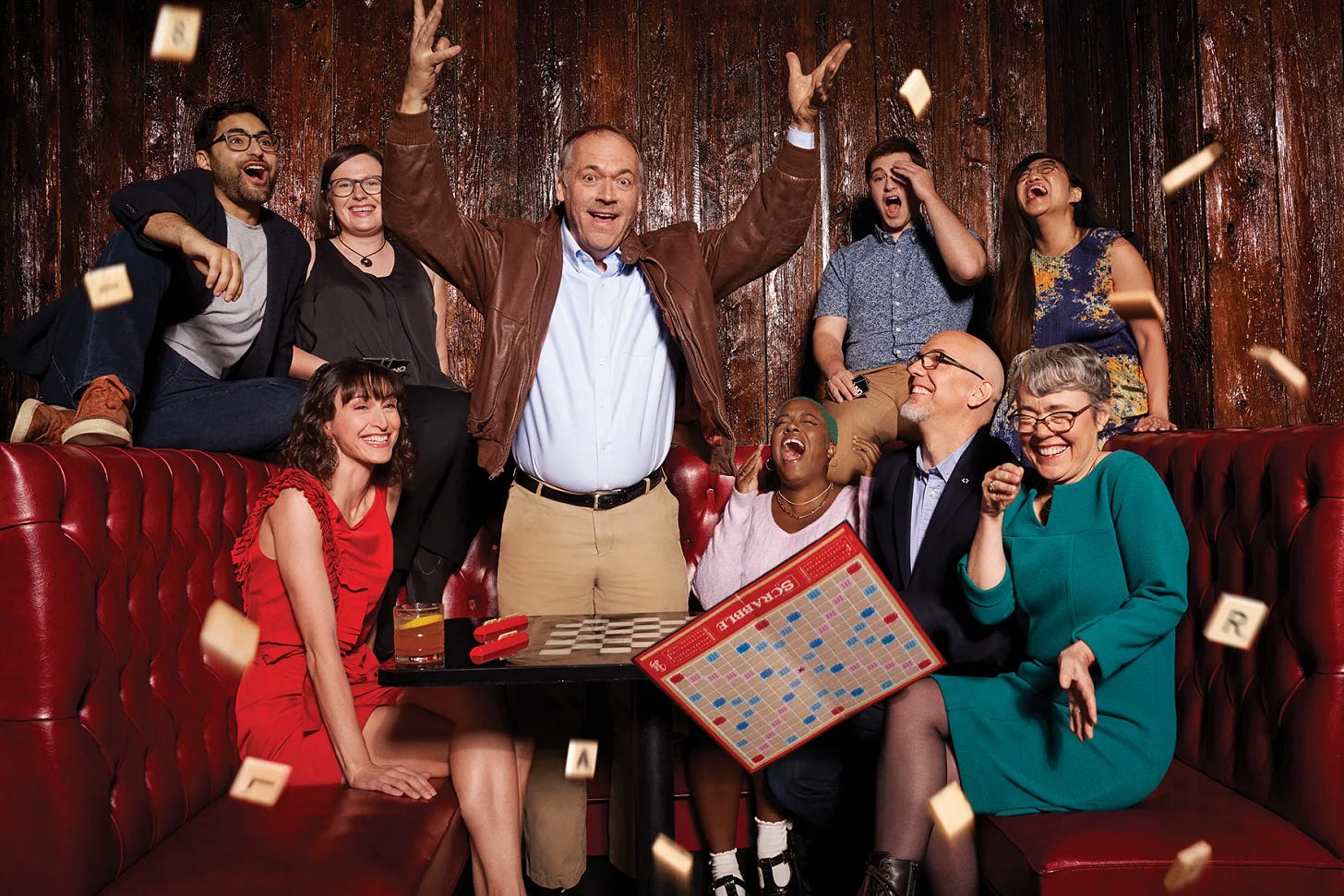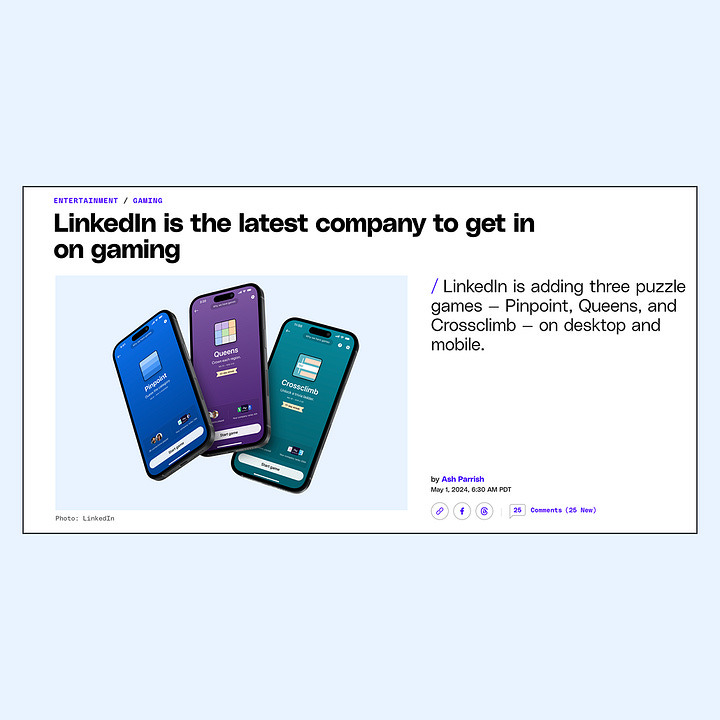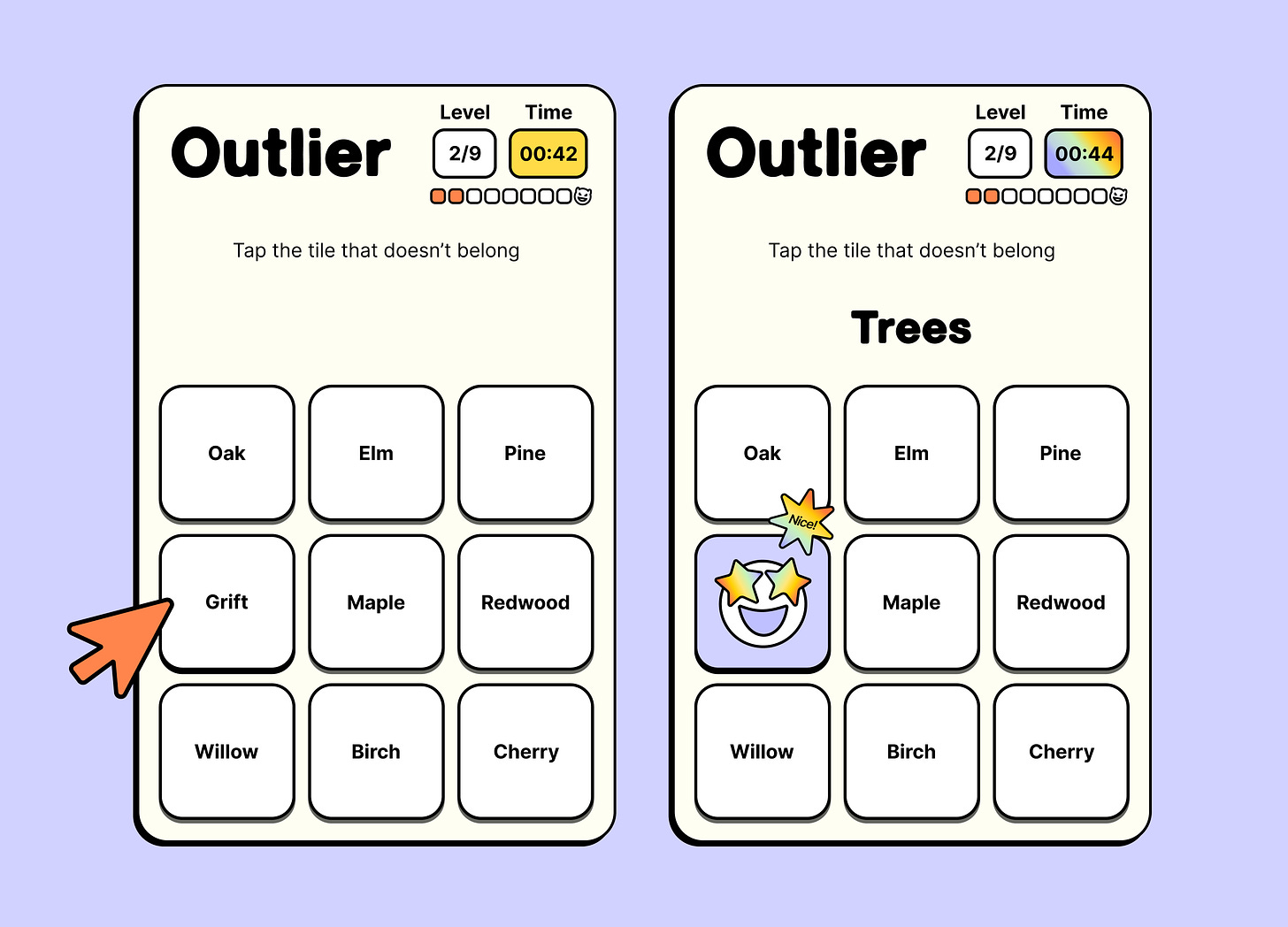What's in a game?
Daily puzzles explored. Plus a new game for you and yours: introducing Outlier.
WE’RE LIVING IN THE GOLDEN AGE of the daily game. The Mini Crossword, Connections, Bracket City, Fluxis, Caleb’s Inferno, Immaculate Grid. These are just a few of the bite-sized wordplay snacks available to the curious (or bored). Jumping from one to the next, I find these low-fi teasers are jazzercise for the mind. Patrick Bateman’s morning routine took him from face masks to eye balm to 1,000 sit-ups. Mine looks more like bouncing from The New York Times games app to The Atlantic’s to independent games like TimeGuessr and Minute Cryptic. I finish the routine with a flurry of group texts to compare scores with friends. For several months now, this games gamut left me with a sneaking suspicion that perhaps I could make my own (more later).
Games are an antidote to humdrum corporate slog. ‘Adulthood’ isn’t as invigorating or colorful as we once anticipated, and it’s too easy to harp on bad news. But if we can ignore capitalist calamity and embrace friendly competition, daily games help us mark the passing years more than other non-time metrics (say, average temperature in the arctic, geriatric presidencies, active conflicts with a nuclear threat, etc). Games proliferation! It’s cloud nine for a guy like me. Daily games are the modern smoke break, and I like to smoke a pack a day.
For most of you, Wordle was your entry into this universe. Like Tiger King and sourdough starter, Wordle benefited from COVID lockdown hysteria. In 90 days, the game went from a thoughtful birthday present for Josh Wardle’s wife to acquired by The New York Times. The simple 5-letter puzzle swept the English-speaking world and brought many new souls into the word game racket. It also brought in many new games designers peddling “Wordle for Blank” dailies. (Framed, Bandle, and Worldle are my favorites). Now, The Times sells access to Wordle as part of their Games-only subscription for ~$50 per year. Two million people subscribe to this service, perhaps blissfully unaware of the news on the NYT front page.

The Times is the undisputed king of the daily game. More than 10 million people play every week, and it is certainly the fastest growing section of the Times’ empire with (likely) the strongest margins. In 2024, The New York Times Company did $2.6B in revenue, with $443M in EBITDA. Games likely contributed more than $50M to this total.1 Today $NYT’s market cap exceeds $9B. It’s not crazy to say the games division could be a stand-alone $1B company.2 Not bad for a business with an entire department for puns and portmanteus. They have turned game design into both high art and cash cow. One employee joked that The Times is a gaming company that ‘happens to offer news’.
And other media businesses have noticed. Hearst Media bought Puzzmo at the end of 2023 and has integrated the games hub into their publication kingdom: San Francisco Chronicle, Popular Mechanics, and Esquire. In the last year, LinkedIn, Apple News, and The Atlantic have all launched their own games hubs too. The business model is simple: if readers stay on our sites longer and interact with more, we can sell more advertisements and subscriptions. The designers and editors for these new games include some of the most well-known figures in the New York Times Crossword universe. (For an outstanding primer on this niche subculture, I can’t recommend the documentary Wordplay highly enough).




But what makes for a great game?
Why is Battleship boring, but Settlers of Catan delightful? What makes Will Shortz’s crossword puzzles sing, while USA Today’s fall flat? And how do games reach cult status: ask your grandma about Bridge or your midwest friend about Eucher— there is but one ‘card game’ in these communities.
Great games are clever. They align incentives well, employ useful design, and inspire a a bit of mischief. Too much learning makes a game feel like school, too little strategy and it feels like sheer chance. A bit of clever wordplay or a memory challenge or a race against the clock or a piece of idiosyncratic knowledge— You don’t just ‘play’ great games, these are enigmas designed to be solved. Great games make you feel you’re ‘getting away with something’. At the end of my morning routine, I can feel both victorious and smart or battered and defeated. But regardless I feel a sense of accomplishment far greater than the brief time I devoted. I truly love games.
Outlier
I decided to try my hand at making my own. Another game to add to the daily puzzle canon—I’m calling it Outlier. I don’t yet know if it’s ‘great’, but I think it could be. If you’ve ever wondered what sort of reef fish sounds most like a rock band (Blue Tang), or which film director blends in on a list of African Countries (Sergio Leone), then this is for you.
Today marks day 35 of Outlier. Each puzzle has 9 rounds, each round 9 terms. By the end of year one, I’ll have come up with 30,000 terms, and I’m tickled pink just thinking about it. The premise is simple: one of these things is not like the other.
On each screen, players encounter nine terms — eight belong to a common set, one sticks out as the outlier. Ex: MET, MARINER, MARLIN, BREWER, BRAVE, BEAR, ROYAL, ROCKIE, RED SOCK. These are Baseball Teams, written in the singular. And while there is a real team called the Rockies (Colorado) and Red Socks (Boston), there is no Bear (not in baseball, anyway). When the player clicks BEAR the mischief begins.
In the next round, BEAR becomes part of the core set. This might be as part of a Large Mammals category with TIGER and LION. Or maybe synonyms for Endure, like TOLERATE or WEATHER. Or perhaps Homophones like RAY, PEACE, or KNIGHT. You get the idea. This routine continues for 9 levels every day. Players are racing against the clock to beat their best time. As with this example, there are tricks throughout — sure TIGER is a large mammal and RAY is a homophone, but they are also both baseball teams.
I hope you love it. Video of gameplay below (more fun to play here). And if you read this essay closely, it’s pumped up with hints to tomorrow’s (July 2nd) puzzle. Happy solving.
Since the company bundles their subscription packages and reports finances overall (not by division), this is an educated guess (and ‘educated’ is generous). I used 2 million games-only subscribers paying $50 per year. Assuming 50% margins (based on similar apps) = $50M in EBITDA. Even if that guess is high, there is also uncounted ad revenue from the 10 million non-subscription players every week.
Two simple ways of backing into the $1B company number. 20x EBITDA is conservative by today’s standards for gamified digital apps (for an extreme example, Duolingo trades at 200x). Alternatively we can take the real-time value of $9.2B for NYT stock, and say 12% of the EBITDA is worth 12% of the company (.12 x $9.2B = $1.1B). This is irresponsibly simple, but all the best math happens on ‘napkins’.






